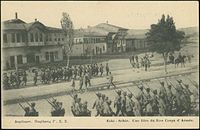You can help expand this article with text translated from the corresponding article in Turkish. (November 2020) Click for important translation instructions.
|
| This article needs additional citations for verification. Please help improve this article by adding citations to reliable sources. Unsourced material may be challenged and removed. Find sources: "Battle of Kütahya–Eskişehir" – news · newspapers · books · scholar · JSTOR (February 2010) (Learn how and when to remove this message) |
| Battle of Kütahya–Eskişehir | |||||||||
|---|---|---|---|---|---|---|---|---|---|
| Part of the Greco-Turkish War (1919–22) | |||||||||
 Greek cavalry charge. | |||||||||
| |||||||||
| Belligerents | |||||||||
|
|
| ||||||||
| Commanders and leaders | |||||||||
| İsmet Pasha |
Constantine I of Greece Anastasios Papoulas | ||||||||
| Strength | |||||||||
|
Greek source: 95,750 men Turkish source: 55,000 men 711 light and heavy machine guns 160 cannons |
Greek source: ~110,000 men Turkish source: 106,000 men (11 divisions, 1 cavalry brigade) 908 light and heavy machine guns 318 cannons | ||||||||
| Casualties and losses | |||||||||
|
1,643 killed 4,981 wounded 374 prisoners 30,809 soldiers deserted 18 cannons, 47 heavy and 34 light machine guns lost |
1,491 killed 6,472 wounded 110 missing | ||||||||
| Turkish War of Independence | |
|---|---|
|
The Battle of Kütahya–Eskişehir (Greek: Μάχες Κιουτάχειας-Δορυλαίου, Turkish: Kütahya-Eskişehir Muharebeleri), was fought between July 10 and July 24 (or June 27 and July 10 in the old calendar, then in use in Greece), 1921 when the Greek Army of Asia Minor clashed with the Turkish troops commanded by İsmet Pasha in defence of the line of Kara Hisâr-ı Sahib (present day Afyonkarahisar)-Kütahya-Eskişehir.
It was also known in some Greek historiography as the Battles of Kutahya-Dorylaion. It was part of the Greek Asia Minor Campaign and the Turkish War of Independence of 1919–1922.
Strategically, the battle was of little importance as the Greeks failed to grasp the opportunity to encircle the retreating Turkish troops. This proved later to be a major strategic error, when the two sides had to meet each other again during the much more fierce Battle of Sakarya which turned the tide in favour of the Turks.
The battle
After their halt in the second Battle of Inonu, the Greek staff decided to make a new offense to capture the cities of Afyonkarahisar, Kütahya and Eskişehir with their inter-connecting rail-lines. King Constantine arrived in Anatolia to inspire the soldiers and to command the attack.
The Greek Army managed to break through the Turkish resistance and occupied the towns of Kara Hisâr-ı Sahib (in March), and later (in July) Kütahya and Eskişehir (Dorylaion in Greek), together with their inter-connecting rail-lines.
The Turks despite their defeat managed to avoid encirclement and made a strategic retreat on the east of Sakarya river. On August 5, 1921 İsmet Pasha was replaced by Birinci Ferik Fevzi Pasha as the Minister of the General Staff (Erkân-ı Harbiye-i Umumiye Reis Vekili) of the Ankara government after his failure to check the Greek offensive.
The State and Greek army leadership, including King Constantine, Prime Minister Dimitrios Gounaris, and General Anastasios Papoulas, met at Kütahya where they debated the future of the campaign. The Greeks, bouyed by their victory, failed to appraise rationally the strategic situation that favoured the defending side; instead, in the overall climate of enthusiasm, the leadership was polarised into the risky decision to pursue an engagement with the Turks on their last line of defence, close to Ankara. Only few voices supported a defensive stance, but they were not heard.
After a delay of almost a month, that gave adequate time to the Turks to organise their defences, 7 of the Greek divisions marched to Sakarya River.
References
- Επίτομος Ιστορία Εκστρατειας Μικράς Ασίας 1919–1922, Εκδόσεις Διευθύνσεως Ιστορίας Στρατού, Αθήναι 1967, page 145 (in Greek)
- ^ Turgut Özakman: Şu Çılgın Türkler, August 2005, Bilgi publishing house, 52. Edition, ISBN 975-22-0127-X, page 705 (footnote 1). (in Turkish)
- Türk Kurtuluş Savaşında İsmet İnönü (Hazırlayan: Genelkurmay Askeri Tarih ve Stratejik Etüt (ATASE) Başkanlığı), İnönü Foundation. (in Turkish)
- Επίτομος Ιστορία Εκστρατειας Μικράς Ασίας 1919–1922, Εκδόσεις Διευθύνσεως Ιστορίας Στρατού, Αθήναι 1967, page 153: 2,526 officers, 107,476 soldiers (in Greek)
- Tarih İçinde Polatlı Archived September 17, 2011, at the Wayback Machine, Ankara Polatlı Belediyesi (Ankara Polatlı Municipality), page 111 (Pdf page 7)
- Επίτομος Ιστορία Εκστρατειας Μικράς Ασίας 1919–1922, Εκδόσεις Διευθύνσεως Ιστορίας Στρατού, Αθήναι 1967, page 204 (in Greek)
Notes
- 55,000 men= 15 infantry divisions, 4 cavalry divisions and 1 cavalry brigade. Towards the end of 1920 Turkish divisions had each 2,500-3,000 men, some divisions consisted of only 300-700 men.
| Turkish War of Independence | |||||||||||||||
|---|---|---|---|---|---|---|---|---|---|---|---|---|---|---|---|
| Concepts | |||||||||||||||
| National awakening | |||||||||||||||
| Elections | |||||||||||||||
| Issues | |||||||||||||||
| Campaigns |
| ||||||||||||||
| Agreements |
| ||||||||||||||
| Timeline | |||||||||||||||

